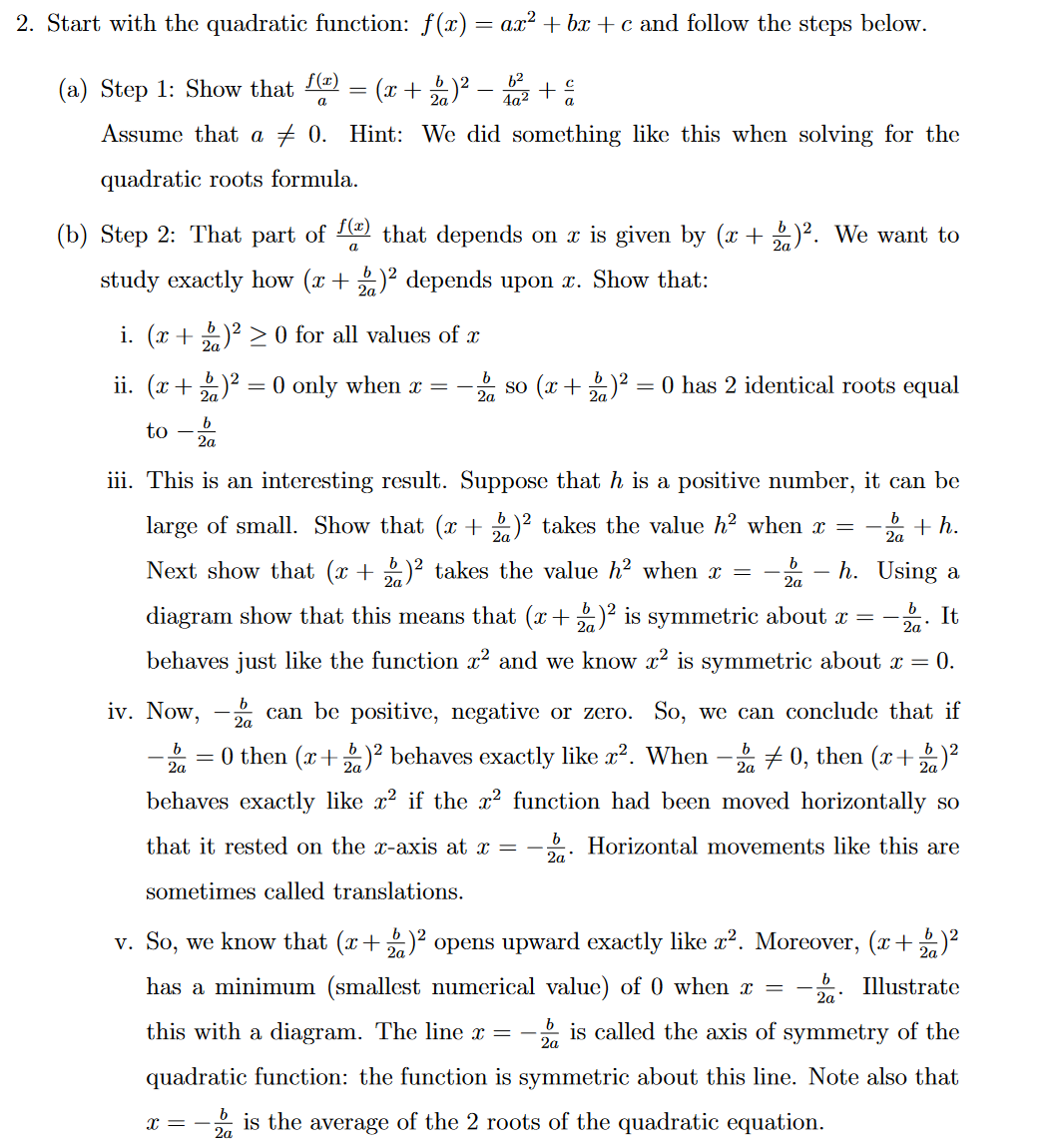2. Start with the quadratic function: f(x) = ax² +bx+c and follow the steps below. 62 (a) Step 1: Show that f(x) (x + 2)² − b 2 + c - a 2a Assume that a 0. Hint: We did something like this when solving for the quadratic roots formula. = (b) Step 2: That part of (a) that depends on x is given by (x + 2)². We want to f(x) a study exactly how (x + 2)² depends upon x. Show that: i. (x+)² ≥ 0 for all values of ii. (x + 2)² = 0 only when x = - so (x + 2)² = 0 has 2 identical roots equal 2a 2a to b 2a b +h. 2a iii. This is an interesting result. Suppose that h is a positive number, it can be large of small. Show that (x + 2)² takes the value h² when x = Next show that (x + 2)² takes the value h² when x = h. Using a diagram show that this means that (x + 2)² is symmetric about x = - It behaves just like the function x² and we know x² is symmetric about x = 0. 2a
2. Start with the quadratic function: f(x) = ax² +bx+c and follow the steps below. 62 (a) Step 1: Show that f(x) (x + 2)² − b 2 + c - a 2a Assume that a 0. Hint: We did something like this when solving for the quadratic roots formula. = (b) Step 2: That part of (a) that depends on x is given by (x + 2)². We want to f(x) a study exactly how (x + 2)² depends upon x. Show that: i. (x+)² ≥ 0 for all values of ii. (x + 2)² = 0 only when x = - so (x + 2)² = 0 has 2 identical roots equal 2a 2a to b 2a b +h. 2a iii. This is an interesting result. Suppose that h is a positive number, it can be large of small. Show that (x + 2)² takes the value h² when x = Next show that (x + 2)² takes the value h² when x = h. Using a diagram show that this means that (x + 2)² is symmetric about x = - It behaves just like the function x² and we know x² is symmetric about x = 0. 2a
Glencoe Algebra 1, Student Edition, 9780079039897, 0079039898, 2018
18th Edition
ISBN:9780079039897
Author:Carter
Publisher:Carter
Chapter9: Quadratic Functions And Equations
Section9.2: Transformations Of Quadratic Functions
Problem 50PFA
Related questions
Question

Transcribed Image Text:2. Start with the quadratic function: f(x) = ax² +bx+c and follow the steps below.
(a) Step 1: Show that f(¹)
a
Assume that a 0. Hint: We did something like this when solving for the
quadratic roots formula.
-
(b) Step 2: That part of f(x) that depends on x is given by (x + b)². We want to
a
(x + 2)² − b ² + €
a
study exactly how (x + 2)² depends upon x. Show that:
i. (x + 2)² ≥ 0 for all values of
2a
b
2a
ii. (x + 2)² = 0 only when x =
2a
to
iii. This is an interesting result. Suppose that h is a positive number, it can be
large of small. Show that (x + 2)² takes the value h² when x =
h. Using a
b
+h.
2a
2a
b
Next show that (x + 2)² takes the value h² when x =
diagram show that this means that (x + 2)² is symmetric about x = - It
behaves just like the function x² and we know x² is symmetric about x = 0.
b
2a
iv. Now,
-
X=-
b
so (x + 2)² = 0 has 2 identical roots equal
2a
b
can be positive, negative or zero. So, we can conclude that if
2a
2a
2a
= 0 then (x + 2)² behaves exactly like x². When -20, then (x+21) ²
behaves exactly like x² if the x² function had been moved horizontally so
that it rested on the x-axis at x =
Horizontal movements like this are
sometimes called translations.
b
2a*
2a
v. So, we know that (x+ 2)² opens upward exactly like x². Moreover, (x + 2)²
has a minimum (smallest numerical value) of 0 when x = - Illustrate
this with a diagram. The line x = - is called the axis of symmetry of the
quadratic function: the function is symmetric about this line. Note also that
is the average of the 2 roots of the quadratic equation.
b
2a
2a
Expert Solution
This question has been solved!
Explore an expertly crafted, step-by-step solution for a thorough understanding of key concepts.
Step by step
Solved in 3 steps with 3 images

Recommended textbooks for you

Glencoe Algebra 1, Student Edition, 9780079039897…
Algebra
ISBN:
9780079039897
Author:
Carter
Publisher:
McGraw Hill


Algebra & Trigonometry with Analytic Geometry
Algebra
ISBN:
9781133382119
Author:
Swokowski
Publisher:
Cengage

Glencoe Algebra 1, Student Edition, 9780079039897…
Algebra
ISBN:
9780079039897
Author:
Carter
Publisher:
McGraw Hill


Algebra & Trigonometry with Analytic Geometry
Algebra
ISBN:
9781133382119
Author:
Swokowski
Publisher:
Cengage


Algebra: Structure And Method, Book 1
Algebra
ISBN:
9780395977224
Author:
Richard G. Brown, Mary P. Dolciani, Robert H. Sorgenfrey, William L. Cole
Publisher:
McDougal Littell

College Algebra
Algebra
ISBN:
9781305115545
Author:
James Stewart, Lothar Redlin, Saleem Watson
Publisher:
Cengage Learning